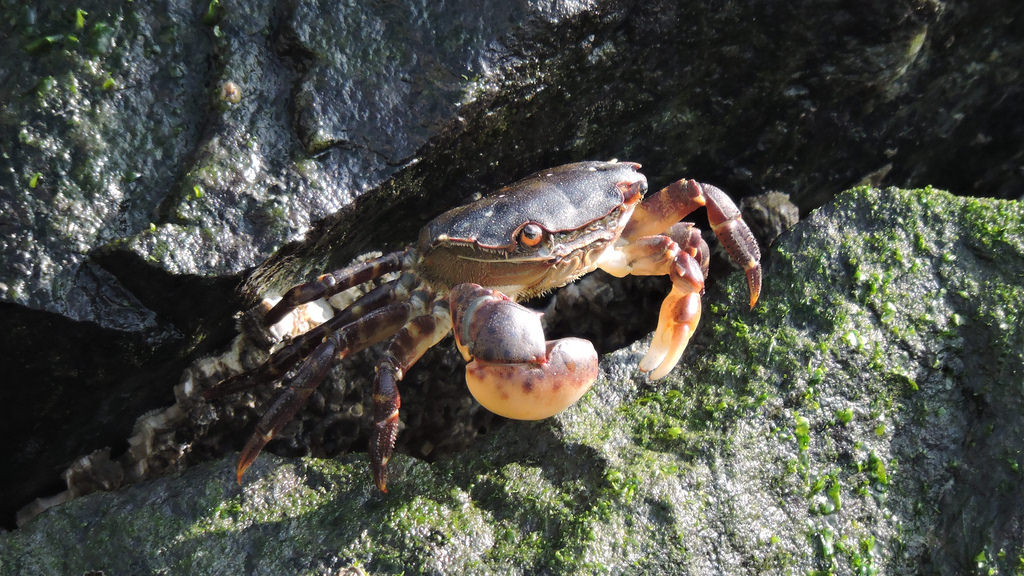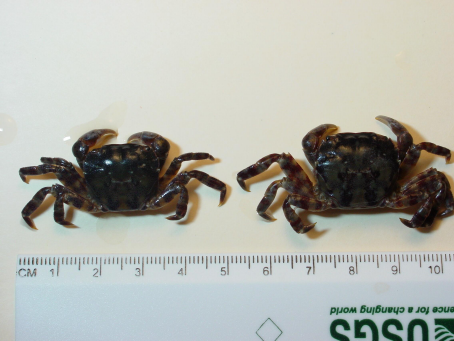Asian Shore Crab Class
The Asian shore crab plays an important role in effecting the structure of the prey communities in their newly invaded habitats Brousseau 2001. The Asian Shore Crab H.

Maryland Biodiversity Project Asian Shore Crab Hemigrapsus Sanguineus
Live grass shrimp are released while two raw prawn drawers labelled with a circle.

Asian shore crab class. The crabs without the adaptation to harden and thicken their shells when in the presence die out because they can be eaten but the ones with the adaptation live on to reproduce and to pass on the genes that allow the mussel to harden their shells when they sense an Asian shore crab. Their coloration can range from orange-brown to green or even purple. Raw prawns are released while a live grass shrimp drawer labelled with a square is placed in front of the cuttlefish.
Cross-intertidal transects at a western Long Island Sound estuary site provided estimates of the density of the non-native Hemigrapsus sanguineus Asian Shore Crab from 1998 to 2017 and measurements of crab size carapace width. Asian shore crabs are a problem where I live. This decline was driven by.
You wont find a beach in Connecticut thats not crawling with these crabs which grow to be about the size of a nickel. It is expected to continue moving northward along the Maine coast. The Asian shore crab Hemigrapsus sanguineus has a negative influence on the mussel consumption of the European green crab and thus its resulting growth rates.
The invasive Asian shore crab is a threat to marine ecosystems according to University of Maine-Machias professor Brian Beal. There is a distinctive banding pattern present on the legs and the claws. While there is still some uncertainty about the long-term ecological impact that this invasive species would have in the community the rapid dispersal of this invader can be detrimental.
The Asian shore crab Hemigrapsus sanguineus is native to coastal and estuarine habitat along the east coast of Asia. Have your class become citizen scientists for the National Park Services and help scientists understand more about this unusual species of crabs. By participating in this program students will learn about the Asian Shore Crabs and how they are invading the shores of Jamaica Bay.
Another possibility is to utilize. The Asian Shore Crab Hemigrapsus sanguineus - was first identified on American shores in New Jersey in 1988. The asian shore crab introduced from the western north pacific ocean to the united states in the mid 1980s williams and mcdermott 1990 is now the most common species of intertidal crab in southern new england and long island sound lohrer and whitlatch 1997 ahl and moss 1999 gerard et al 1999 and can reach densities of 150 crabs m.
Sanguineus was first introduced to the New England coast in 1988 from Japan where it is indigenous. The carapace color ranges from green to purple to orange-brown to red. Squarish shell greenpurple to orangebrown to red three spines along the outside of the shell behind each eye banding pattern on walking legs distinguishing feature in juveniles.
You can catch them by hand during low tide by lifting. Suspended in tidal water for a month before developing into juvenile crabs the larvae can be transported over great distances a possible means of new introductions. Tim Cox BDN McMahan had worked at the Gulf of Maine.
These small crabs are identified by a square-shaped shell and three spines on each side of the carapace. More information More information Dont need the entire report. This video was produced by Margo Urheim Hannah Stowe Luke Downs and Noah Krupnick at Tufts University as part of the undergraduate research and media proje.
Prey selection and consumption of common molluscs and macroalgae by the Asian shore crab Hemigrapsus sanguineus were investigated in the laboratory. First introduced to North America in the 1980s they now infest intertidal habitats from Maine to Florida competing with native species for food. We also collect data on native crabs and other invasive species such as the Asian shore crab.
CW from 2005 to 2017. Asian shore crab Hemigrapsus sanguineus competes with and preys on crabs and shellfish particularly juvenile mussels or oysters. It has light and dark bands along its legs and red spots on its claws.
Hemigrapsus sanguineus is commonly called the Asian shore crab and is native to the Asia-Pacific region. The crab spread rapidly after its discovery and breeding populations currently. They will learn where these crabs are coming from how they are getting here from their.
It also occupies habitats very similar to native mud crabs. The Asian shore crab has a square-shaped shell with 3 spines on each side of the carapace. It has a very broad diet and in its introduced range has the potential to affect populations of native species such as crabs fish and shellfish by disrupting the food web.
United States Geological Survey Source. Females can produce 50000 eggs per clutch and 3 to 4 clutches per season. Sanguineus due to direct and indirect competition for food and shelter such as rocks shells and vegetation Armstrong et al.
The structure of the shell of the mussel has evolved so that its function now. We target the low intertidal area of rocky shorelines. Since 2001 average intertidal density declined by 5 per year.
To survey green crab populations we use a meter square quadrat as a unit of measurement and we sample 10 of these quadrats at each. Asian shore crabs and raw prawns are simultaneously released while a live grass shrimp drawer labelled with a triangle is placed in front of the cuttlefish to be opened after one minute. Its since made its way as far north as Schoodic Point Maine and as far south as North Carolina.
Sanguineus is a relatively small intertidal shore crab native to cobbleboulder coastlines in the western Pacific Ocean from Hong Kong Island to Sakhalin Island China Japan Korea Russia 22 N to 49 N. Asian shore crabs play an important role in. Maenas may be displaced by H.
The Asian shore crab is an invasive species found along the Atlantic coast of the United States native to the coastal waters of the western. Species native to the New England coast as well as invasive species such as the Green Crab C. The Asian shore crab also affects this species by consuming settling post-larvae and displacing juveniles from their refuge habitat under rocks Griffen Guy Buck 2008.
The mussel Mytilus edulis the clam Mercenaria. The species was first observed in North America near Delaware Bay 39N 75W in 1988 and a variety of evidence suggests initial introduction via ballast water early in that decade. What to look for Features.
The Asian shore crab breeds from May to September twice as long as many native crabs. Our monitoring sites span much of mid-Coast Maine from Damariscotta to Yarmouth. Malacostraca Summary of Invasiveness H.
Crabs of three size classes 1218 1925 2631 mm carapace width collected from the rocky intertidal from May to November 1998 and were offered three mollusc species.

Photos Of Asian Shore Crab Hemigrapsus Sanguineus Inaturalist

Asian Shore Crab Hemigrapsus Sanguineus Species Profile

Asian Shore Crab Hemigrapsus Sanguineus Invasive
Posting Komentar untuk "Asian Shore Crab Class"